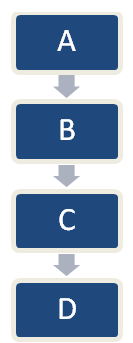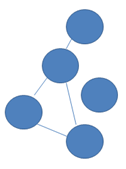Formal and Informal Communication
Communications in an organization are of different kinds and they are classified as – Formal Communication and Informal Communication.
Formal communication
It is that type of communication that follows the channels which are designed by the management and it flows through the hierarchical form of management. The communication can be in any form i.e. written or oral but is recorded in an official record. This type of communication is done deliberately so as to pass on the ideas, information, queries, feedback, changes etc. It generally takes place between the superior and subordinate, worker and the operations head, one manager with other managers of same level etc. The levels cannot be skipped to communicate informal manner. It is broadly classified into two categories- vertical formal communication and horizontal formal communication.
Vertical communication
Vertical communication means that the flow of communication is either in upward to downward or downward to upward format. When the flow of communication is upward to downward then it means that the superior is communicating with the subordinate and when the flow is opposite i.e. downward to upward then the subordinate is communicating with the superior.
In downward communication, the information that flows is regarding the tasks, orders, rules, deadlines, policies, information, procedures, feedback etc. In upward communication the information that flows is regarding the new ideas, queries and doubts, asking for leave, reports, submission of tasks etc.
Horizontal and lateral communication
This kind of information takes place between the same level of departments, divisions and managers. As at the same levels, the problems will be somewhat of similar nature and they can help each other to tackle them. They generally discuss suggestions, queries, mutual problems, coordination, cooperation, product ideas, feedbacks etc.
Communication network informal communication:
The communication network is the pattern which the people of the organization will follow and through which the communication will take place.
- Chain: single chain is the structure or the network through which the superiors and subordinates communicate with each other. As the information needs to be transferred on a regular basis from top officials or managers to their juniors or subordinates then this pattern is the most suitable.

Here, the information will be transferred from A to B (A is superior to B), from B to C (B is superior to C) and so on. - Wheel: in this form of communication network, there is a superior who acts as the focal point and hub of the network. He is at the centre and all the subordinates under him will communicate with each other through him only. They do not directly communicate with each other.

Here, in this picture of the wheel network, A is the superior who is at the centre of the wheel network and all the subordinates B, C, D and E will communicate their ideas, thoughts, queries, reports, feedback etc directly to A rather than communicating with each other.
- Circular: in this form of network the communication will take place with the two adjacent employees or colleagues. This network is not very effective because the flow of communication will be slower than other networks.

Here, in this network, communication will take place between the two adjacent employees. A will communicate with B and E. B will communicate with A and C. And so on. - Free flow: this network is established so that fast communication can take place. In this network, the employees can communicate with each other freely without following any scalar chain or hierarchy.

Here, in a free follow network, A will be able to communicate with B, C, D and E without restrictions, similarly, others will also be able to communicate with every person in the network. This network is usually followed by the team working on a single project. - Inverted V: in this network, the subordinate can communicate with his or her superior and also with the superior of the superior. This helps in the easy and fast transfer of information and reports.

Here, in this network of inverted V, C and D are subordinates of B and B is subordinate of A. C and D can communicate with B as well A directly.
Informal communication
Informal communication is the transfer of ideas, thoughts, feelings, discussions, rumours etc without following formal lines of management hierarchy. It is a formation that builds on the basis of connections like social connections or friendships. This channel is very useful if the information needs to be transferred quickly. The manager can make use of this communication network to pass on the information in a short span of time. Under this network, the relations become friendly and stronger as it is a tension-free environment so it satisfies the social needs of a person (according to Maslow’s need hierarchy theory). This network has its own disadvantages because the information source cannot be located because the information transfer is random. This network also leads to rumours which can spread easily.
The types of this network are as under:
Single strand network
Under this informal network, communication transfer is a bit in an orderly manner and is done in a sequence.

Probability network
In this network, the communication takes place on random selection and some people can even be missed out.

Gossip network
This network is very random and any person can talk to any other without following any sequence. This usually happens during the tea breaks in the canteen.

Cluster network
Under this network, the information is only transferred to those whom the sender trusts.
